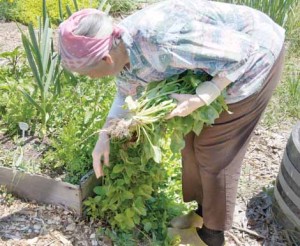By Jan Jackson
The luxury of walking outside the door and plucking something fresh and vine ripened is not just a treat for the palette but the pocket book. All you need is a little space in which to tuck a tomato or cucumber plant, a container that would grow a lettuce bowl or a space to build a little square foot garden reminiscent of colonial times. And the good news is, depending on what you choose to plant, there is still time to do it.
Lee Ann Marsaglia, a Master Garden volunteer at the Brunk House in Salem, likes the rule of three and pots tomatoes, marigolds and nasturtiums together to combine utility with beauty. Marsaglia is also a proponent of raised square-foot gardens, which take up very little space, yield a high production per square foot, and allow you to garden above infertile soil out of the reach of pets.
A square-foot garden uses an open or enclosed bottomed box filled with soil and divided with a grid into sections. A good size is about 4 feet by 4 feet so you can access it easily from all sides. A plywood sheet can be attached to the bottom of a box, which can then be placed on a table top or raised platform for those who wish to garden without bending or squatting or to make gardening easy for wheelchair, cane or walker users.
Divide the bed into approximately 1 square foot units and mark out with sticks, twine or sturdy slats to ensure the square foot units remain visible as the garden matures. Different seeds are planted in each square to ensure a rational amount of each type of crop is grown and to conserve seeds instead of over planting, crowding and thinning plants. Common spacing is one plant per square for larger plants, (broccoli, basil, etc.) four plants per square for medium large plants like lettuce, nine plants per square for medium small plants like spinach and 16 per square for small plants such as onions and carrots.
A single tomato plant might take a full square as might herbs such as oregano, basil or mint while most strawberry plants could be planted four per square with up to 16 radishes per square. If you plant something tall or something that climbs, make sure it is supported with lattice or netting and that it doesn’t shade the other plants.
Here are a few guidelines to remember in constructing a raised bed garden:
• Keep the bed narrow and match its length to the site and the watering system.
• A north-south orientation is best for low-growing crops so both sides of the bed get direct sunlight.
• Build a frame for your bed out of untreated pressure-treated lumber, redwood or brick so there won’t be any chemicals to leak into the soil.
• Build it ground level or raised (if you don’t like bending over).
• Add 12 inches of nice rich soil and your plants will thrive (see your local plant nursery or extension agent).
Some may recall the victory gardens of World War II fame when folks planted to reduce the pressure on the public food supply brought on by the war effort.
Different times, but if small space vegetable gardening sounds like a good idea to you today check out Square Foot Gardening, by Mel Bartholomew, research the topic on one of many Internet sites or contact your local nursery or county OSU extension office.